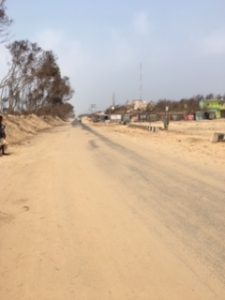Lonely Planet, a well-known travel guide publisher, had once described the Konark-Puri Marine Drive as a “stunning beauty along the sea no nature lover can ignore”.
Alas! Not anymore.
Cyclone Fani has caused incalculable damage to this stretch; has shorn it of its vaunted charm. It has flattened lakhs of trees on either side and, in doing so, made coastal Odisha more vulnerable to cyclone-related disasters.
Environmentalists feared the Marine Drive alone could be swallowed by the Bay if large-scale plantation is not taken up on a mission mode.
“It was a horrible sight I can never forget. The sea wall came gushing towards us as the wind speed picked up. As we ran for protection, the waves hit the shores, leaving behind a sheet of sand that still covers the road,” said Manas Panda, who ekes out a living selling coconut on the Chandrabhaga beach.

“We were warned but I decided to visit the beach with my friends. God has saved us,” he said recalling the horror of May 3, when the cyclone made landfall close by.
Few miles away at Khalakapatna village, which rests between the sea and the marine drive, Octogenarian Hari Nayak was seen erecting a bamboo boundary wall a week after the cyclone.
“I had feared for the worst. Around noon we could see the sea swelling up. The high tidal waves came towards us at a menacing pace. Had it reached up to the village, we would have all got washed away. It was more ferocious than the 1999 Super Cyclone,” he said, still shaken by the calamity.
According to some estimates, 80 per cent of trees along the coast have been destroyed. All that remains in the aftermath of the cyclone is the skeletal structure of a handful of trees that have withstood the ferocity of wind speeds. To a nature lover, it’s a heart-wrenching site.
“The thick growth along the marine drive acted as a buffer for the coastal belt from the cyclonic storms. Now that it no longer remains, the coastal area would be more vulnerable to high-velocity winds. Even a depression could cause damage to nearby villages,” environmentalist Sudarshan Das said.
Cyclone Fani was a perfect example of extreme weather systems developing in the Bay of Bengal because of global warming. There will be more such type of cyclones in the times to come. Global warming will also lead to rise in sea level and by the end of this century, it would have risen by five metres, inundating the coastline. This can be contained to a large extent if we begin to regenerate mangrove and other forests along the coast, he suggested.
Echoing his views, environmentalist Jaya Krushna Panigrahi said, “We need a sea wall along the coast made up of casuarina and other plantations. It should be taken up on a massive scale, not on an ad hoc basis”.
“Odisha is prone to natural calamities and we are failing to combat the disaster,” he said.


